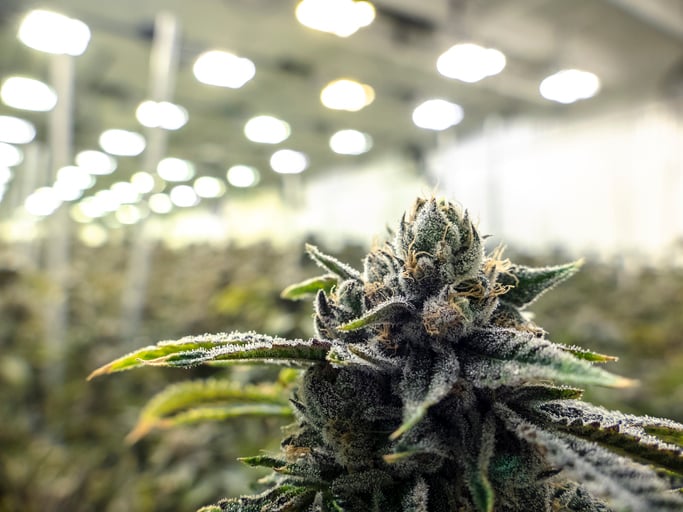This has turned out to be quite the transformational year for the North American legal cannabis industry. After more than a year of debate in the Senate, Canada is on the verge of becoming the first developed country in the world to legalize adult-use marijuana. Following an overwhelming show of support for the Cannabis Act (56 votes in favor to 30 opposed) in the Senate, it's just a matter of time until the smaller details (i.e., a new amendment added by the Senate) are worked out between both houses of Parliament.
What exactly does legal marijuana mean for Canada's cannabis supply chain? Though estimates vary, the industry is probably looking at adding $5 billion in annual revenue, which comes atop the revenue they're already generating from the sale of medical cannabis and via exports to foreign countries where medical marijuana has been legalized. This expected growth is why investors have been willing to pay such an exorbitant premium for pot stocks.

Image source: Getty Images.
These top-tier marijuana stocks could be money-losers in 2019
However, a grim reality may await investors in 2019. Namely, that marijuana stock profits could come in well below expectations. Though a majority a pot stocks are expected to be profitable next year, according to Wall Street, many are still expected to be valued at price-to-earnings ratios that are very high relative to the broader market.
Perhaps what's most notable is that despite rapidly growing sales -- most marijuana stocks can likely expect triple-digit year-over-year sales growth in 2019 -- two of the most prominent Canadian marijuana stocks, Canopy Growth Corp. (CGC 5.46%) and Aurora Cannabis (ACBFF 0.98%), could wind up losing money next year.
In terms of peak production capacity and distribution channels, Canopy Growth and Aurora Cannabis are heavyweights in the weed industry. Canopy Growth announced earlier this year that it had tripled its licensed production capacity with Health Canada to 2.4 million square feet, and was well on its way to peaking at 5.7 million square feet of growing capacity. Even though the company has been secretive about its annual production, 500,000 kilograms isn't out of the question at full capacity.
Meanwhile, Aurora Cannabis has been busy partnering and buying its way to greater capacity. Once the all-share deal to buy MedReleaf closes, Aurora Cannabis could be on track for 570,000 kilograms of peak annual production. Combined with Canopy Growth, these two juggernauts could produce in the neighborhood of 1.1 million kilograms of cannabis a year by 2020 or 2021.
Yet, year-over-year expected sales growth of nearly 300% for Canopy Growth and around 640% for Aurora Cannabis in 2019 may not be enough to push either company into the black.

Image source: Getty Images.
Here's why Canopy Growth and Aurora Cannabis could lose money next year
How's this possible?
For starters, Canopy Growth and Aurora Cannabis are running their businesses much in the same way Amazon.com has operated for more than a decade. Rather than focusing on profitability, these two cannabis companies have been reinvesting every ounce of operating cash flow into capacity expansion. Management's line of thinking for both companies is that they should garner as many lucrative long-term supply contracts, and hoard as much market share as possible, in the early going, and the profits will take care of themselves later. Reinvesting this cash flow into organic capacity expansion, the research and development of new products, and their distribution channels could certainly push both companies into the red.
Secondly, both companies have been active acquirers, albeit Aurora Cannabis has been considerably more aggressive than Canopy Growth of late. Acquisition-related costs run the risk of weighing down the earnings per share of both companies in 2018 and 2019, especially with Aurora in the process of making the largest marijuana acquisition in history: the $2.5 billion, all-share buyout of Ontario-based MedReleaf.
A third and final issue is that both companies -- and the entire legal weed industry, to be fair -- have relied on bought-deal offerings to finance their acquisitions, partnerships, and capacity expansion efforts. With negligible operating cash flow and projects that could cost well in excess of $100 million, Canopy and Aurora have had little choice but to turn to offering common stock, convertible debentures, stock options, and/or warrants to investors in order to raise capital.
Each and every one of these capital raises either immediately, or over the course of a few quarters or years, increases the outstanding share counts of these pot stocks. If there's a bright side, it'll make any net loss look smaller on a per-share basis since there are an increasing number of shares outstanding. On the other hand, it also makes any per-share profit appear smaller. Should either company turn a profit in 2019, their ballooned share counts will likely reduce their full-year EPS to a pittance, therefore pushing their forward price-to-earnings ratios into the stratosphere.

Image source: Getty Images.
This is a buzz you might be best off avoiding
While there are no shortage of pot stock enthusiasts ready to proclaim Canopy Growth or Aurora Cannabis as the greatest thing since sliced bread, there are clearly a lot of industry dynamics still to be hashed out. It'll take years before we have a clearer picture of supply and demand in Canada, which means little in the way of clarity with regard to marijuana's per-gram price. And without this critical piece of information, trying to understand how profitable marijuana stocks could be is pure guesswork.
In other words, keep your expectations in check, and don't get caught up in the marijuana hype surrounding Canada's legalization efforts.







